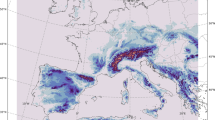Abstract
This work presents the results of complex analysis of the field data and of mathematical modeling of the ice ring structure more than 4 km across, which was identified by the space images of South Baikal in April 2009. The measurements revealed that the ice thickness was 74 cm in the center of the structure, decreased to 43 cm at a distance of 2 km, and increased up to 70 cm and more beyond the ring. The ice water in the central part was warmer by 0.5°C and less saline (for 2 mg/kg) relative to the periphery of the structure. According to the tracer movements, the maximum velocities of the ice currents (3–4 cm/s) were observed at a distance of 2–3 km from the center of the structure with minimum ice thickness. The event was modeled using several mathematical models of various scales. The 3-D nonhydrostatic modeling of the large-scale processes on the basis of the temperature measured in the area of the structure showed the presence of local anticyclonic circulation, where the velocities of the currents increased up to the maximum (5–7 cm/s) at the distance of 2–3 km from the center and then decreased. The variations in the ice thickness in the area of the ring structure were modeled on the basis of these calculation results. The ice thicknesses determined in the context of the Stefan problem for the 2-D axis-symmetrical temperature distribution model are close to the measured ones. According to the model, the formation of the ring structure spans a period of 25–35 days. The origination of the dark ring on the satellite images is related to the lower ice thickness relative to the ambient areas and to the water level in microfractures closer to the ice surface.
Similar content being viewed by others
References
N. G. Granin, Nauka is pervykh ruk, No. 3, 22–23 (2009).
V. K. Balkhanov, Yu. B. Bashkuev, and V. B. Khaptanov, Tech. Phys. 55(9) 1266–1269 (2010).
A. V. Kouraev, M. N. Shimaraev, F. Remy, A. Yu. Ivanov, V. N. Golubev, A. Suknev, and A. Bartsch, in Proceedings of ESA Living Planet Symposium (ESA, Bergen, 2010), no. SP-686.
T. J. McDougall and P. M. Barker, Getting Started with TEOS-10 and the Gibbs Seawater (GSW) Oceanographic Toolbox (SCOR/IAPSO WG127, 2011).
B. Cushman-Roisin, K. A. Korotenko, C. E. Galos, and D. E. Dietrich, J. Geophys. Res. 112, C03S14 (2007).
N. G. Granin, D. Jewson, R. Yu. Gnatovskii, L. A. Levin, A. A. Zhdanov, A. I. Averin, L. A. Gorbunova, V. V. Tsekhanovskii, L. F. Doroshenko, N. P. Min’ko, and M. A. Grachev, Dokl. Akad. Nauk 366(6), 835–839 (1999).
E. A. Tsvetova, Hydrobiologia 407, 37–43 (1999).
E. A. Tsvetova, in Mathematical Modeling in Problems of Harmonious Exploitation (YuFU, Rostov on Don, 2012), pp. 198–202.
I. A. Aslamov, V. V. Kozlov, G. V. Kirillin, I. B. Mizandrontsev, K. M. Kucher, M. M. Makarov, A. Yu. Gornov, and N. G. Granin, Journal of Great Lakes Research 40(3), 599–607 (2014).
V. V. Kozlov, in Proceeding of the Lyapunov Conference (IDSTU SB RAS, Irkutsk, 2012), p. 23.
A. A. Zhdanov, N. G. Granin, R. Yu. Gnatovskii, and V. V. Blinov, Geograph. Prirod. Res., No. 1, 55–60 (2009).
V. I. Verbolov, V. M. Sokol’nikov, and M. N. Shimaraev, Hydrometeorological Regime and Heat Balance of Lake Baikal (Nauka, Moscow, 1965) [in Russian].
M. I. Kuz’min, G. V. Kalmychkov, V. F. Geletii, V. A. Gnilusha, A. V. Goreglyad, B. N. Khakhaev, L. A. Pevzner, T. Kawai, N. Yoshida, A. D. Duchkov, V. A. Ponomarchuk, A. E. Kontorovich, N. M. Bazhin, G. A. Makhov, Yu. A. Dyadin, F. A. Kuznetsov, E. G. Larionov, A. Yu. Manakov, B. S. Smolyakov, M. M. Mandel’baum, and N. K. Zheleznyakov, Dokl. Earth Sci. 362(7), 1029–1031 (1998).
J. Klerkx, T. I. Zemskaya, T. V. Matveeva, O. M. Khlystov, B. B. Namsaraev, O. P. Dagurova, L. P. Golobokova, S. S. Vorob’eva, T. P. Pogodaeva, N. G. Granin, G. V. Kalmychkov, V. A. Ponomarchuk, H. Shoji, L. L. Mazurenko, V. V. Kaulio, V. A. Solov’ev, and M. A. Grachev, Dokl. Earth Sci. 393(9), 1342–1346 (2003).
N. G. Granin, S. I. Muyakshin, M. M. Makarov, K. M. Kucher, I. A. Aslamov, L. Z. Granina, and I. B. Mizandrontsev, Geo-Mar. Lett. 32(5), 427–436 (2012).
Author information
Authors and Affiliations
Corresponding author
Additional information
Original Russian Text © N.G. Granin, V.V. Kozlov, E.A. Tsvetova, R.Yu. Gnatovsky, 2015, published in Doklady Akademii Nauk, 2015, Vol. 461, No. 3, pp. 343–347.
Rights and permissions
About this article
Cite this article
Granin, N.G., Kozlov, V.V., Tsvetova, E.A. et al. Field studies and some results of numerical modeling of a ring structure on Baikal ice. Dokl. Earth Sc. 461, 316–320 (2015). https://doi.org/10.1134/S1028334X15030204
Received:
Published:
Issue Date:
DOI: https://doi.org/10.1134/S1028334X15030204




